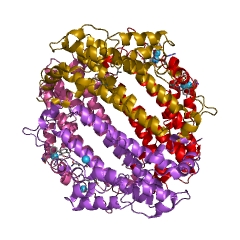
An oxygenase is any enzyme that oxidizes a substrate by transferring the oxygen from molecular oxygen O2 (as in air) to it. The oxygenases form a class of oxidoreductases; their EC number is EC 1.13 or EC 1.14.

An oxygenase is any enzyme that oxidizes a substrate by transferring the oxygen from molecular oxygen O2 (as in air) to it. The oxygenases form a class of oxidoreductases; their EC number is EC 1.13 or EC 1.14.
Most oxygenases contain either a metal, usually iron, or an organic cofactor, usually flavin. These cofactors interact with O2, leading to its transfer to substrate. [1]
Oxygenases constitute a major intracellular source of iron and carbon monoxide [2]
Two types of oxygenases are recognized:
Among the most common monooxygenases are the cytochrome P450 oxidases, responsible for breaking down numerous chemicals in the body.
Oxygenases were discovered in 1955 simultaneously by two groups, Osamu Hayaishi from Japan [4] [5] [6] and Howard S. Mason from the US. [7] [8] Hayaishi was awarded the 1986 Wolf Prize in Medicine "for the discovery of the oxygenase enzymes and elucidation of their structure and biological importance." [9]